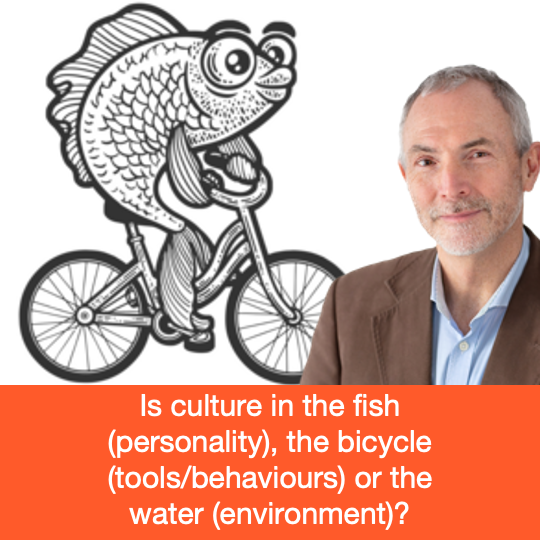Is Culture Like a Fish Out of Water?

In today’s rapidly evolving world, conversations around change—particularly transformational change—are ubiquitous. Leaders and organizations often emphasize the importance of transformation, likening it to the metamorphosis of a caterpillar into a butterfly: a one-way journey, a permanent shift from one state of being to another. This metaphor suggests that once transformation occurs, there’s no turning back. However, is this truly reflective of how change unfolds in the real world?
The Myth of Singular Transformation
The idea of a singular, monumental transformation is appealing. It implies that change is significant and final. However, I question whether this perspective accurately represents the nature of change. Change, in my view, is not a one-time event. Instead, it is a continuous, ever-present process. Rather than a caterpillar’s irreversible transformation into a butterfly, perhaps a more accurate metaphor is that of a chameleon. A chameleon adapts its color to suit its environment, yet fundamentally remains the same creature. This is not to dismiss the importance of change, but to suggest that what we often label as “transformational” might be better understood as adaptive or incremental.
Transactional Versus Transformational Change
If change is the only constant, it becomes less about singular, sweeping transformations and more about ongoing, incremental adjustments. This kind of change is transitional and transactional, evolving slowly over time rather than occurring overnight. The reality is that real change is more akin to evolution than revolution. It happens gradually, piece by piece, until one day we look back and realize that significant transformation has occurred. This is reminiscent of Darwin’s theory of evolution, where small changes accumulate over time, leading to a new species altogether. But unlike the butterfly, this transformation is not immediate; it’s the result of countless smaller changes that accumulate over time.
The Obsession with Transformational Change
Why, then, are we so fixated on the idea of transformational change? I believe it has something to do with ego. There’s a certain allure in being able to claim that a significant transformation occurred under our leadership or during our tenure. It’s about ownership and accountability within a compressed timeframe. When change is packaged as “transformational,” it carries with it a sense of importance and urgency that incremental change lacks. However, the slow, steady march of time brings about change as well—change that is less about the individual and more about the collective passage of time. Staff turnover, evolving products, shifting customer demographics—all of these lead to change. But is this change transformational, or is it simply the wear and tear of living?
The Core of Stability Amidst Change
One of the true challenges of navigating change is identifying what doesn’t change. In the midst of all the transformation, what remains constant? Vision and values are often touted as the immutable core of an organization. However, if these are in a state of constant flux, they lose their substance, becoming mere lip service. There must be some elements that remain stable, whether it’s the core product, core beliefs, or core market. If everything is changing, particularly in a short period of time, that’s not managed change—it’s chaos.
Looking Beyond the Internal Focus
Interestingly, our focus on change is often inward-looking—within our organizations, households, or communities. But significant change often comes from external factors, like climate change. The environment around us, the broader context in which we operate, plays a crucial role in shaping us. Perhaps, if we want to see meaningful change, we should shift our focus outward. By managing the external environment—whether that involves sustainability efforts, cultural context, or community values—we can shape the internal changes we seek.
Creating an Environment for Success
I’ve long believed in the idea that success is inevitable when we create the right environment. Instead of micromanaging individuals, perhaps we should pay more attention to the circumstances in which people operate. This involves curating the right environment—call it culture if you will—that allows people to thrive. Culture is what resides in our hearts and minds, while context is what surrounds us. The two are interconnected, much like a fish and the water it swims in. A fish can only survive and thrive in the right water. If the water is too cold or too hot, no amount of effort on the fish’s part will change its fate. The same holds true for people and organizations: the environment must be conducive to growth and success.
Conclusion
In conclusion, while transformational change is a compelling narrative, it’s often the slow, incremental changes—the evolution, rather than revolution—that truly shape our world. By focusing less on the individual and more on the environment, we can create a culture where success is not just possible, but inevitable.
#ChangeManagement #OrganizationalCulture #Leadership #Transformation #BusinessStrategy #Evolution #WorkplaceCulture #ContinuousImprovement
